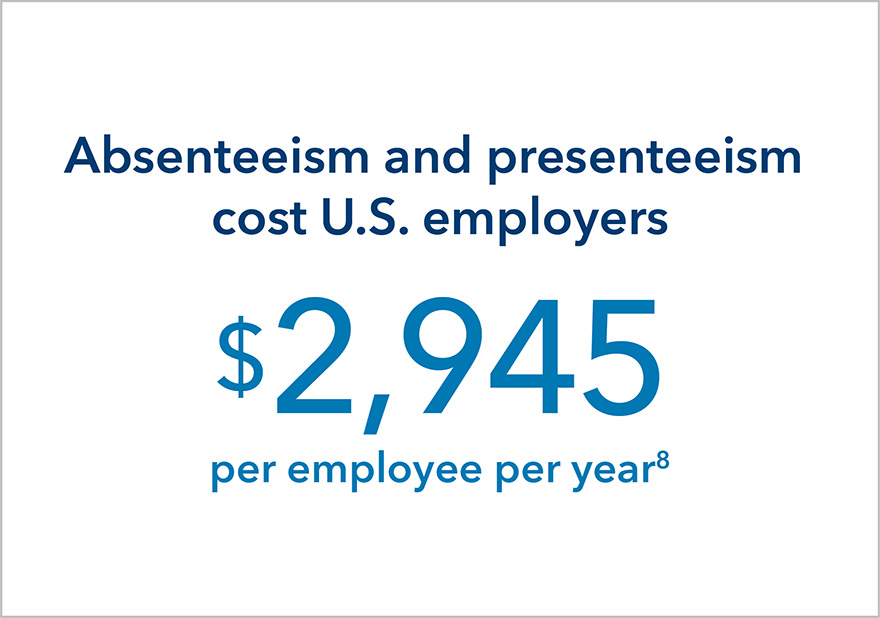

It’s natural to keep an eye on the cost of health care rates. But don’t stop there. Rates aren’t the only health-related costs that impact your business. Your employees’ overall health affects your bottom line in several ways.
The cost of actual health care has become more expensive. While costs held from 2019 to 2020, employers reported a median increase of 8% in 2021.1 And as Americans continue to face the unfolding health impacts of the COVID-19 pandemic, the number of people who need care could increase.
Advanced cancer diagnoses — which are more expensive to treat than early-stage cancers — are expected to rise because of pandemic-related delays in preventive care.2 Cancer became the top driver of large companies’ health care costs in 2022, with 13% of employers saying they’ve seen more late-stage cancers among their workers.3
Along with delays in preventive care, the pandemic spurred an increase in risky behaviors — like lack of exercise, poor nutrition, increased substance use, and smoking — that may lead to a decline in health and a rise in health care spending.4 More than 50% of primary care clinicians say their patients with previously well-managed conditions have become worse since the pandemic began — and they’re seeing more patients reporting depression, anxiety, and acute pain.5
When employees are in poor health, they’re likely to need time off work. Or they might work when they’re unwell, a situation known as “presenteeism” that impairs job performance. Working while sick can delay an employee’s recovery time and increase their risk of future health problems — as well as absences.6 Presenteeism can also occur when an employee is dealing with physical pain, mental health issues, or burnout.
You might not notice the financial impact of lost productivity on your business. These indirect costs can affect your bottom line in ways that are less apparent than rate increases — but no less real. Productivity losses linked to absenteeism and presenteeism from chronic illnesses and injuries cost U.S. employers $2,945 per employee per year.7 That number includes sick days, short-term disability, long-term disability, and impaired job performance.
Smaller businesses feel the effect of absenteeism even more, since an employee who misses work due to illness represents a larger percentage of the company’s workforce. It isn’t as easy for a sick employee’s work to be transferred to another person in the department — often, the sick employee is the department.
Reducing absenteeism and presenteeism begins with a plan
Investing in your employees’ health is an investment in your company. Research shows that employees who are in good health are more likely to be engaged with their work.9 And for every $1 employers spend on health coverage, they get $1.47 back in direct medical costs, productivity, recruitment, retention, and more.10 As you evaluate health plans for your employees, consider how well they can help you minimize absenteeism and presenteeism costs in these areas:
Prevention — Timely screenings for conditions like diabetes, high blood pressure, and colon, breast, and lung cancer can detect problems before they become serious for your employees. Screenings help your employees stay healthy, and help you reduce or avoid absenteeism and presenteeism.
Mental health support — Everyone can use support for their mental and emotional well-being. Look for a health plan that offers a variety of tools to help your employees handle life’s daily challenges — like stress, anxiety, relationships, and sleep. Some employees may prefer in-person support groups or classes, while others may want digital choices, like apps and text-based coaching.
Condition management — Chronic conditions are among the leading drivers of health care costs for employers. For healthier employees and fewer sick days, consider plans that offer dedicated programs and resources to help your employees stay on top of their ongoing conditions, from hypertension to chronic pain.
Employee engagement — Engaged employees miss fewer workdays due to health issues and are more productive while on the job. Research finds that disengaged workers cost their company the equivalent of 18% of their annual salary.11 That’s $9,000 a year for an employee earning $50,000. Look for health plans that give your employees tools and wellness programs that help them take an active role in their physical and emotional well-being.


When you’re looking at the cost of different health plans, be sure to factor in how those plans will help you minimize other care costs. Because there’s more to your company’s health care expenses than monthly rates.
Resources you may find helpful



- 1
“Cancer Now Top Driver of Employer Health Care Costs, Says Business Group’s 2023 Health Care Strategy and Plan Design Survey,” Business Group on Health press release, August 23, 2022, businessgrouphealth.org/en/who-we-are/newsroom/press-releases/2023-lehcspds.
- 2
Cancer Market Trends for 2022, Advisory Board, page 26, April 2022.
- 3
See note 1.
- 4
“Medical Cost Trend: Behind the Numbers 2022,” PwC, accessed September 1, 2022, pwc.com/us/en/industries/health-industries/library/behind-the-numbers.html.
- 5
Quick COVID-19 Primary Care Survey, The Larry A. Green Center and Primary Care Collaborative, September 10–14, 2021, and October 8–13, 2021, green-center.org/covid-survey.
- 6
Gail Kinman and Christine Grant, “Presenteeism During the COVID-19 Pandemic: Risks and Solutions,” Occupational Medicine, November 18, 2020, academic.oup.com/occmed/article/71/6-7/243/5986708.
- 7
“The Cost of Poor Health,” Integrated Benefits Institute, 2019, ibiweb.org/resources/cost-of-poor-health-infographic-2019-data#.
- 8
See note 7.
- 9
“Engaging Employees in Their Health and Wellness,” CDC Workplace Health Resource Center, accessed September 1, 2022.
- 10
“The Value of Employer Sponsored Health Coverage,” U.S. Chamber of Commerce, August 2022, youtu.be/QH1VjpX4U08.
- 11
Jake Herway, “Increase Productivity at the Lowest Possible Cost,” Gallup.com, October 15, 2020, gallup.com/workplace/321743/increase-productivity-lowest-possible-cost.aspx.
Kaiser Permanente health plans around the country: Kaiser Foundation Health Plan, Inc., in Northern and Southern California and Hawaii • Kaiser Foundation Health Plan of Colorado • Kaiser Foundation Health Plan of Georgia, Inc., Nine Piedmont Center, 3495 Piedmont Road NE, Atlanta, GA 30305 • Kaiser Foundation Health Plan of the Mid-Atlantic States, Inc., in Maryland, Virginia, and Washington, D.C., 2101 E. Jefferson St., Rockville, MD 20852 • Kaiser Foundation Health Plan of the Northwest, 500 NE Multnomah St., Suite 100, Portland, OR 97232 • Kaiser Foundation Health Plan of Washington or Kaiser Foundation Health Plan of Washington Options, Inc., 1300 SW 27th St., Renton, WA 98057
Congratulations! You have successfully saved this item.
To access your Saved items any time, open the "Saved Items" folder in the top right corner of the page.
It seems that you do not have cookies enabled. Please enable cookies to make use of all of our site's functionality.
You haven't collected any items yet.
- Save Content
Click the "Save" icon next to the content you want to revisit later.
- Access Your Saved Items
Click on the "Saved Items" link at the top of the page or use the URL we create for you.
Be sure to copy and paste the URL we create for you before you leave the site.
1-5 of 14
Your Link
After leave the site, your saved items will be saved for you at this URL:
https://business.preview.dpaprod.kpwpce.kp-aws-cloud.org/saved-items?user=wOQl0Q6Z9BShare your list
Show Disclaimer +


